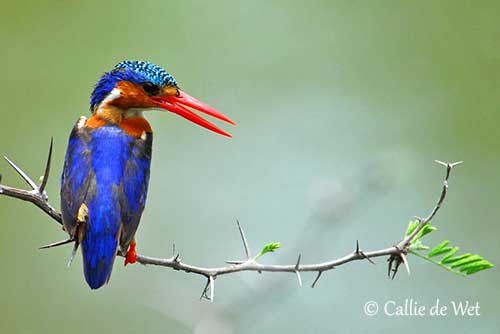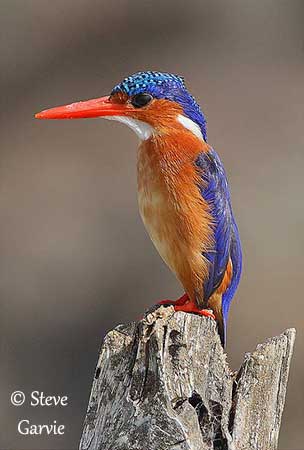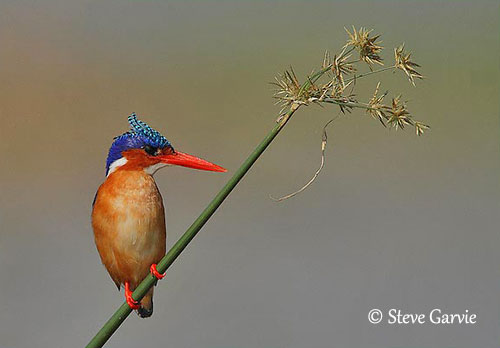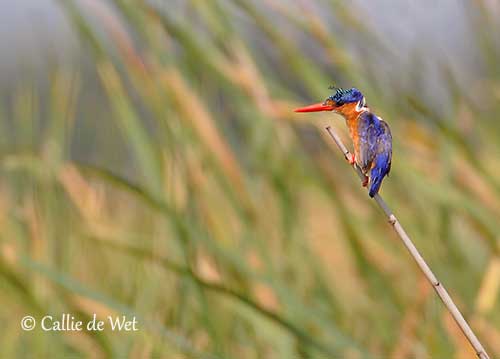
Fr: Martin-pêcheur huppé
Ang: Malachite Kingfisher
All: Haubenzwergfischer
Esp: Martín Pescador Malaquita
Ita: Martin pescatore malachite
Nd: Malachietijsvogel
Sd: Malakitkungsfiskare
Photographers:
Steve Garvie
RAINBIRDER Photo galleries & Flickr Rainbirder
Callie de Wet
GALLERY
Text by Nicole Bouglouan
Sources:
HANDBOOK OF THE BIRDS OF THE WORLD Vol 6 by Josep del Hoyo-Andrew Elliott-Jordi Sargatal - Lynx Edicions, 2001 - ISBN: 848733430X
BIRDS OF AFRICA SOUTH OF THE SAHARA by Ian Sinclair and Peter Ryan - Princeton University Press Princeton and Oxford - ISBN: 0691118159
BIRDS OF THE GAMBIA AND SENEGAL by Clive Barlow and Tim Wacher – Helm Field guides – ISBN: 0713675497
ROBERTS BIRDS OF SOUTH AFRICA by G. R. Mc Lachlan and R. Liversidge – The Trustees of the John Voelcker Bird Book Fund – ISBN: 0620031182
Wikipedia, the free encyclopaedia
Birds of Southern Africa (Tony Roocroft)
BIRDS of THE WORLD - An Online Bird Book
Malachite Kingfisher
Corythornis cristatus
Coraciiformes Order – Alcedinidae Family
INTRODUCTION:
The Malachite Kingfisher is included in the « river kingfisher » group within the family Alcedinidae. This small, bright-coloured kingfisher is common near ponds and slow-moving rivers where it is often perched on reeds or aquatic vegetation. Its behaviour when fishing and breeding is typical of this family.
The species is common across most part of sub-Saharan Africa, and the population appears stable and not threatened.

DESCRIPTION OF THE BIRD:
Biometrics:
Length: 13 cm
Weight: 12-19 gr
The Malachite Kingfisher adult has bright, glossy ultramarine-blue upperparts and hindneck, whereas underparts and face are deep orange-chestnut. Chin and throat are white. The belly is paler, mostly whitish or buffy.
On the head, we can see a rufous supraloral spot. The long, blue tinged malachite-green feathers of forehead and crown are barred black. They form a crest usually carried flat, but when it is raised, it often appears ragged. We can see a conspicuous white spot on the neck side.
The long, pointed bill, legs and feet are red-orange. The eyes are dark brown.
Male and female are similar.
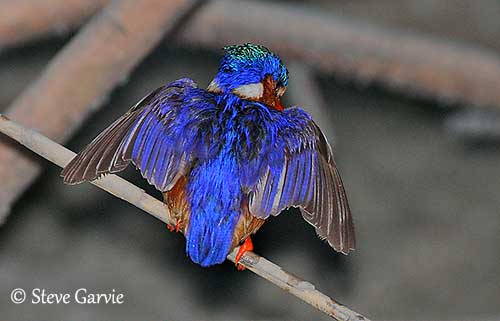
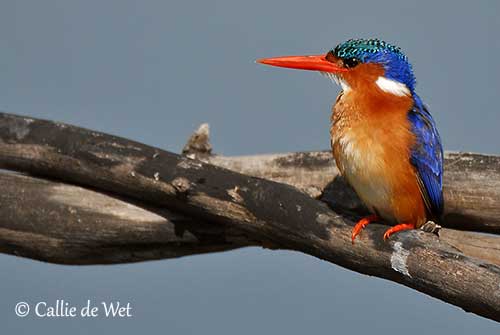
The juvenile has blackish mantle and wing-coverts, with blue gloss and pale markings. The head feathers are shorter on the forehead. The young bird is duller overall, with black bill and legs, until 3 months old.
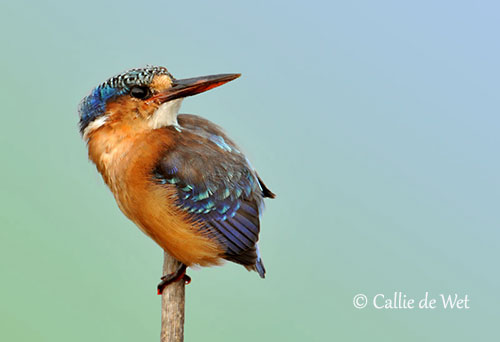
SUBSPECIES AND RANGE:
The Malachite Kingfisher has several subspecies, but the subspecific taxonomy has been somewhat disputed and currently, the authors do not agree with each other. According to some of them, 4-5 subspecies are recognized but still under debate. The races differ in colour intensity on the underparts that are often deeper orange-rufous.
The Malachite Kingfisher occurs in sub-Saharan Africa, from Senegal to Ethiopia and Eritrea, S to South Africa. It is maybe resident in Yemen.
HABITAT:
The Malachite Kingfisher is common in wet areas and fresh waters including lakes and dams, along slow-moving streams and rivers, swamps, marshes, estuaries and mangrove forests. It also frequents man-made habitats such as canals, drainage ditches, reservoirs and irrigated fields.
During the breeding season, it is often seen in small watercourses where it can find suitable banks for nesting.
The species can be seen at high elevation, from 600 metres in Arabia, and up to 3000 metres in Kenya, depending on the range.
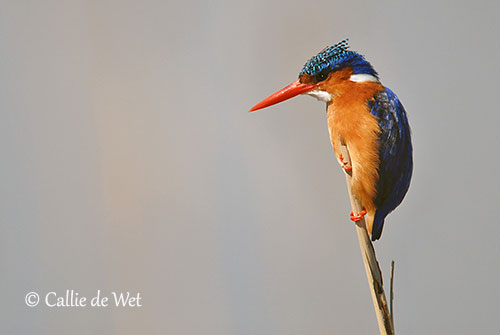
CALLS AND SONGS: SOUNDS BY XENO-CANTO
The Malachite Kingfisher gives high-pitched “peep-peep”, or “kweek” and “seet” when in flight. Both mates make duets, a series ending with a chuckle “ii-tiii-cha-cha, chui chui tuiichi chui”.
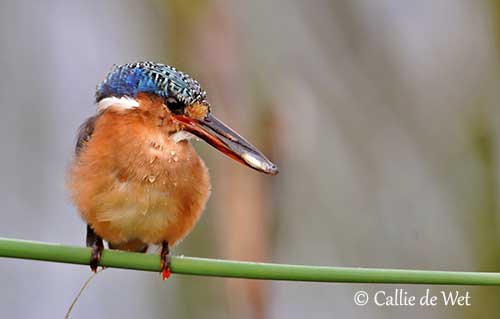
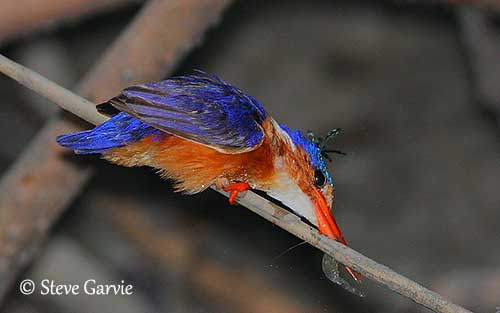
While the bird is waiting for preys, it often bobs the head and flicks its tail, while the crest is raised and lowered. Perches are 20-50 centimetres above the water, usually in areas with scattered vegetation and high fish density. It may catch dragonflies in flight too.
The Malachite Kingfisher is usually solitary outside breeding season.
The breeding season occurs during periods of highest fish density, especially in Kenya and Okavango Basin, just after peak of floods.
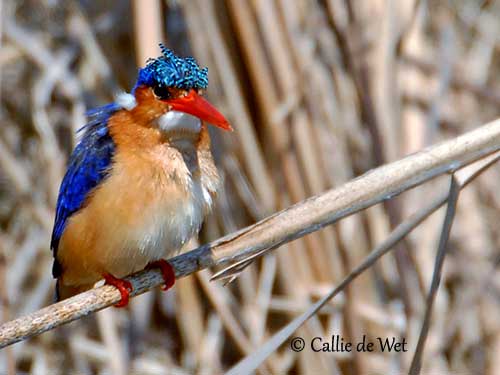
The Malachite Kingfisher is strongly territorial and interactions between owners and intruders may occur, involving threat displays, flying attacks, bill-grappling and aerial chases.
At the beginning of the breeding season, the male performs aerial displays accompanied by calls. Aerial chases also occur. Courtship feeding by male to female is reported when the nest is almost finished. They are monogamous.
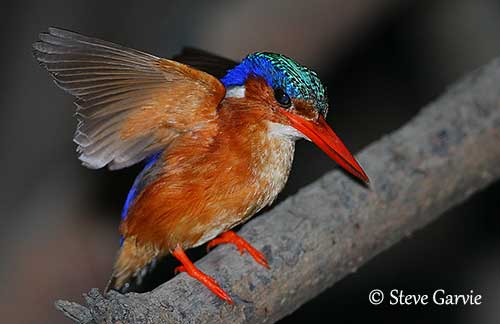
The Malachite Kingfisher is largely resident, but seasonal movements are related to water levels. The juveniles disperse more widely than adults.
The flight is rapid, and the bird usually flies low over water.
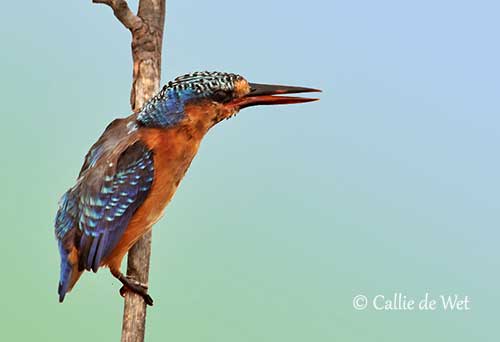
The laying occurs when the water level is low. The female lays 3-6 glossy white eggs at one day intervals. Both adults share the incubation during 14-16 days. The chicks are fed by both parents, but they are brooded mainly by the female. They open the eyes at 10-12 days old, and leave the nest 22-25 days after hatching. They are able to fish within one week after fledging. The adults chase them at 36-40 days old.
PROTECTION / THREATS / STATUS:
The Malachite Kingfisher is widespread and usually common throughout the range. The population is suspected to be stable and the species is currently evaluated as Least Concern.
